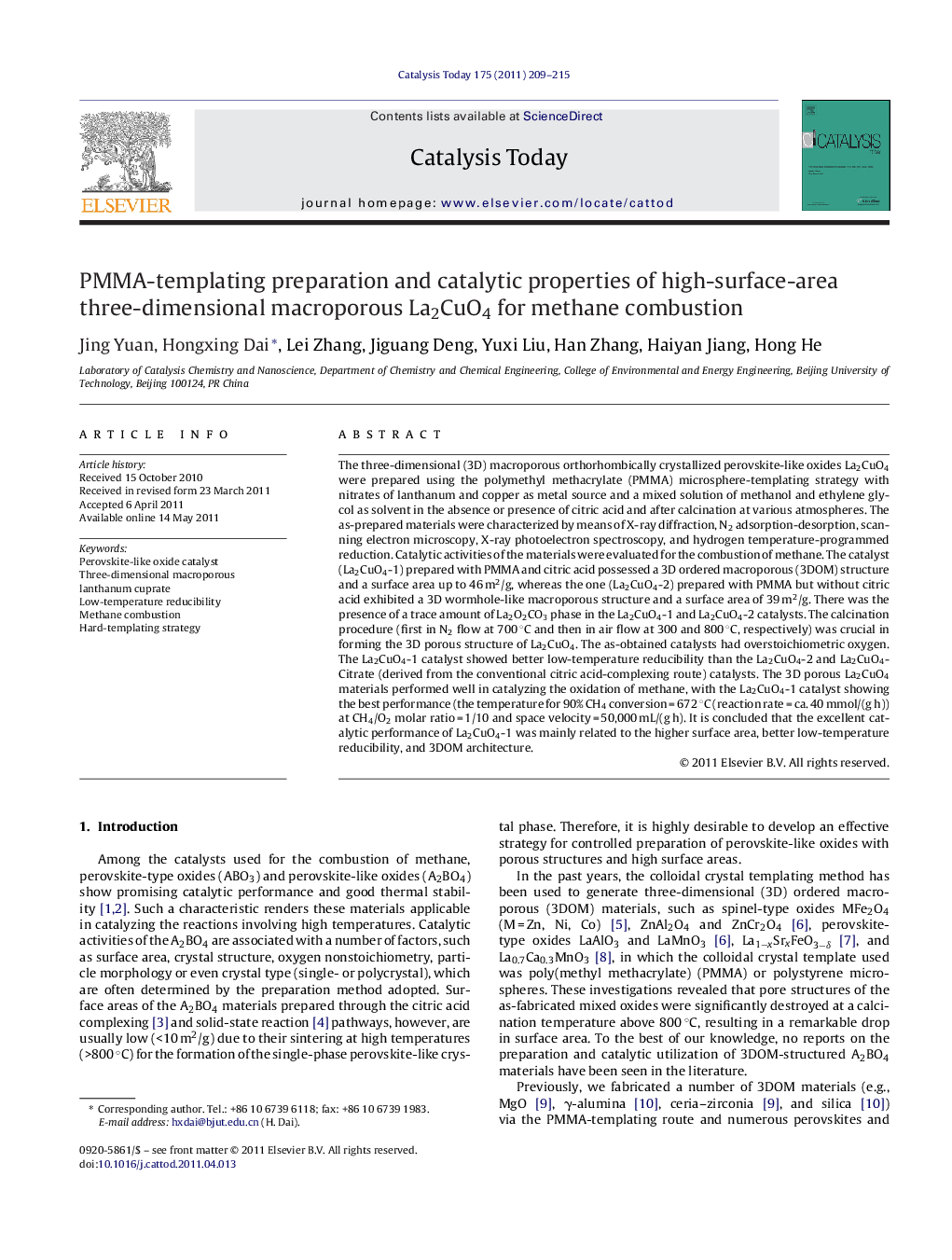| کد مقاله | کد نشریه | سال انتشار | مقاله انگلیسی | نسخه تمام متن |
|---|---|---|---|---|
| 55743 | 47063 | 2011 | 7 صفحه PDF | دانلود رایگان |

The three-dimensional (3D) macroporous orthorhombically crystallized perovskite-like oxides La2CuO4 were prepared using the polymethyl methacrylate (PMMA) microsphere-templating strategy with nitrates of lanthanum and copper as metal source and a mixed solution of methanol and ethylene glycol as solvent in the absence or presence of citric acid and after calcination at various atmospheres. The as-prepared materials were characterized by means of X-ray diffraction, N2 adsorption-desorption, scanning electron microscopy, X-ray photoelectron spectroscopy, and hydrogen temperature-programmed reduction. Catalytic activities of the materials were evaluated for the combustion of methane. The catalyst (La2CuO4-1) prepared with PMMA and citric acid possessed a 3D ordered macroporous (3DOM) structure and a surface area up to 46 m2/g, whereas the one (La2CuO4-2) prepared with PMMA but without citric acid exhibited a 3D wormhole-like macroporous structure and a surface area of 39 m2/g. There was the presence of a trace amount of La2O2CO3 phase in the La2CuO4-1 and La2CuO4-2 catalysts. The calcination procedure (first in N2 flow at 700 °C and then in air flow at 300 and 800 °C, respectively) was crucial in forming the 3D porous structure of La2CuO4. The as-obtained catalysts had overstoichiometric oxygen. The La2CuO4-1 catalyst showed better low-temperature reducibility than the La2CuO4-2 and La2CuO4-Citrate (derived from the conventional citric acid-complexing route) catalysts. The 3D porous La2CuO4 materials performed well in catalyzing the oxidation of methane, with the La2CuO4-1 catalyst showing the best performance (the temperature for 90% CH4 conversion = 672 °C (reaction rate = ca. 40 mmol/(g h)) at CH4/O2 molar ratio = 1/10 and space velocity = 50,000 mL/(g h). It is concluded that the excellent catalytic performance of La2CuO4-1 was mainly related to the higher surface area, better low-temperature reducibility, and 3DOM architecture.
The citric acid-assisted PMMA-templating strategy can generate La2CuO4 with a three-dimensional ordered macroporous (3DOM) structure and a high surface area of 46 m2/g. It is found that the high surface area, good low-temperature reducibility, and porous structure of the 3DOM-structured La2CuO4 are responsible for the excellent catalytic performance for the oxidation of methane.Figure optionsDownload high-quality image (270 K)Download as PowerPoint slideHighlights
► Citric acid-assisted PMMA-templating strategy can generate 3DOM-structured La2CuO4.
► The calcination procedure is a key step in the formation of 3D macroporous structure.
► 3DOM and wormhole-like macroporous structured La2CuO4 possess high surface areas.
► 3DOM-structured La2CuO4 exhibits good low-temperature reducibility.
► Low-temperature reducibility, surface area, and 3D porosity govern catalytic activity.
Journal: Catalysis Today - Volume 175, Issue 1, 25 October 2011, Pages 209–215